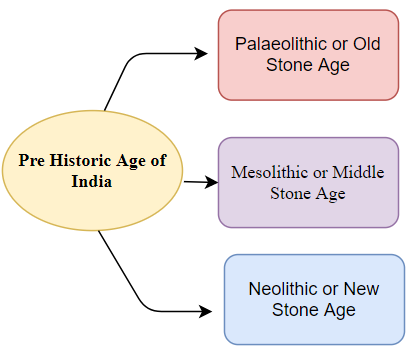Pre Historic Age of India - Ancient History of India
In this article, you will learn about Pre Historic Age of India which is very beneficial for UPSC, SSC, NET and other competitive exams. This topic is a part of Ancient History of India that will help you in knowing about stone age of India and its various divisions. This will sharpen your knowledge and help in getting edge over other aspirants in the examinations.

On the basis of sources of Indian History, it can be divided into three parts: Pre History, Proto History and Historic Age.
The prehistoric period belongs to the time before the emergence of writing. During this time, humans were not civilised and thus no written records are present. The sources of prehistoric age of India include archaeological remains. As, we are dependent only archaeological remains, our knowledge of this period is very limited. Archaeological sources include materials such as stone tools, pottery, artefacts, bones etc.

Human ancestors are likely to have first evolved in Africa and have lived on our planet for about 150,000 years. They later migrated to different parts of the world. The earliest human ancestor species to migrate out of Africa was the Homo erectus.
There has been evidence for the presence of human ancestors in India between two million and one million years ago. The period before the invention of script is broadly divided into Stone Age, Bronze Age and Iron Age.
Stone Age is part of Pre History which includes:
- Palaeolithic or Old Stone Age
- Mesolithic or Middle Stone Age
- Neolithic or New Stone Age
Bronze Age and Iron Age is a part of Proto History. Proto-History refers to a period between pre-history and history when the knowledge of writing was there but we are unable to read it or could not be deciphered. In India Proto-History spans the period around from 3000 B.C. to 600 B.C. covering the Bronze Age and Chalcolithic culture from the beginning of Indus Valley civilization up to the beginning of the historical period in 6th century B.C.
Historical Period is that period of Indian history when written records are available and can be deciphered. The period after 600 B.C. is considered as Historical period in India.
Palaeolithic culture or Stone Age
Old Stone Age is dated between 2,50,000 to 10,000 B.C in India. In 1863, Robert Bruce Foote discovered the first Palaeoliths and established the science of pre-history in India. In the 1930s, H.de Terra and T.T. Paterson undertook a detailed survey of Kashmir and Jammu areas. After this, many historians started showing interest in the discovery of new prehistoric sites and reconstruction of palaeo environments. By the 1960s Indian pre historians started dividing Palaeolithic culture or Stone Age into three parts:
Lower Palaeolithic culture: The lower Palaeolithic around two million years ago and continued upto 60,000 years ago. It is characterized by hand axes, cleavers, chopping tools, and related artefact forms. The tools were all made by removing flakes from a block or core of stone in the required size and shape.
Middle Palaeolithic culture: This culture in India is dated between 3,85,000 and 40,000 BCE (BC). It is characterized by smaller and lighter tools based upon flakes struck from cores.
Upper Palaeolithic culture: This culture flourished around 40,000 years to 10,000 years Before Present. It is characterized by wide range of scrapers, backed blades, points, choppers and burins, and also blade technology.
Mesolithic or Middle Stone Age
In India, Mesolithic cultures started developing around 10,000 BCE and continued up to 1000 BCE, till the beginning of the Iron Age. This culture is associated with the cultures of hunting people, fishermen, pastoralists or people practicing some form of agriculture. This culture comprised of tools made on blades and small blades and include burins, lunettes, crescents, triangles, points, trapeze etc. and have handle of bone or wooden handles to form composite tools. The Mesolithic people lived in semi-permanent and temporary settlements.
Neolithic or New Stone Age
The Neolithic cultures of India flourished in different time periods among which the Neolithic culture of north-western India is the earliest. This is the final phase of Stone Age. This period marked the beginning of agriculture and animal domestication. It began around 6000 to 1000 B.C. During this time, tool was composed of heavy ground tools – pestles, mortars, grinders and pounders also axes and sickles that help in harvesting wild or domesticated plants and grasses. Also, there were many Neolithic cultures which were coexisting with the urban Harappan Civilization which is copper based.
